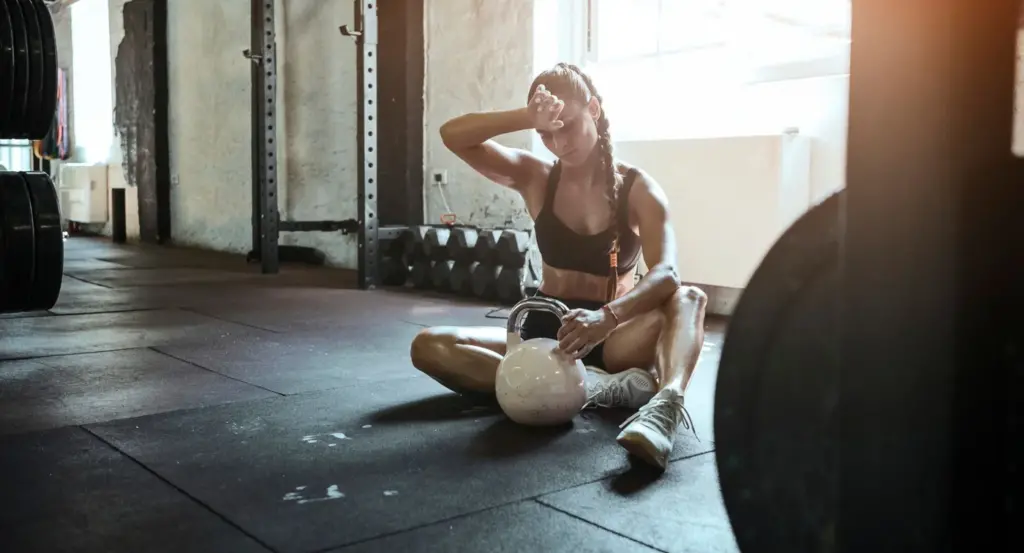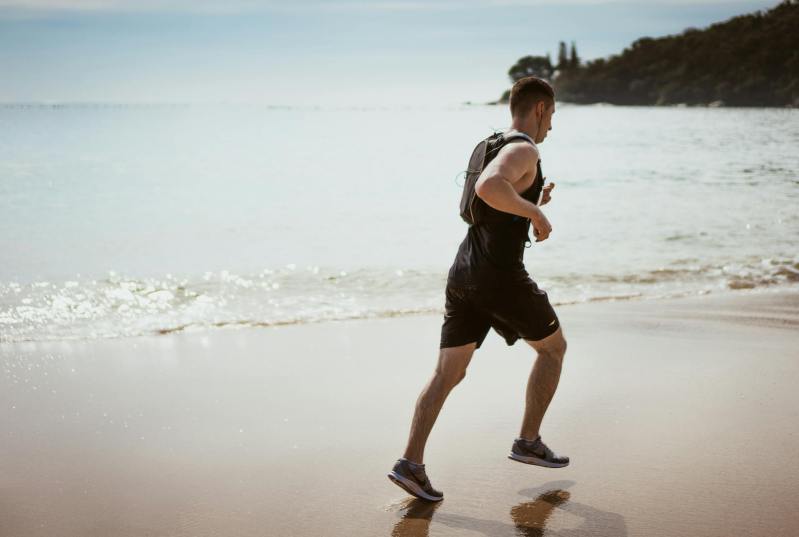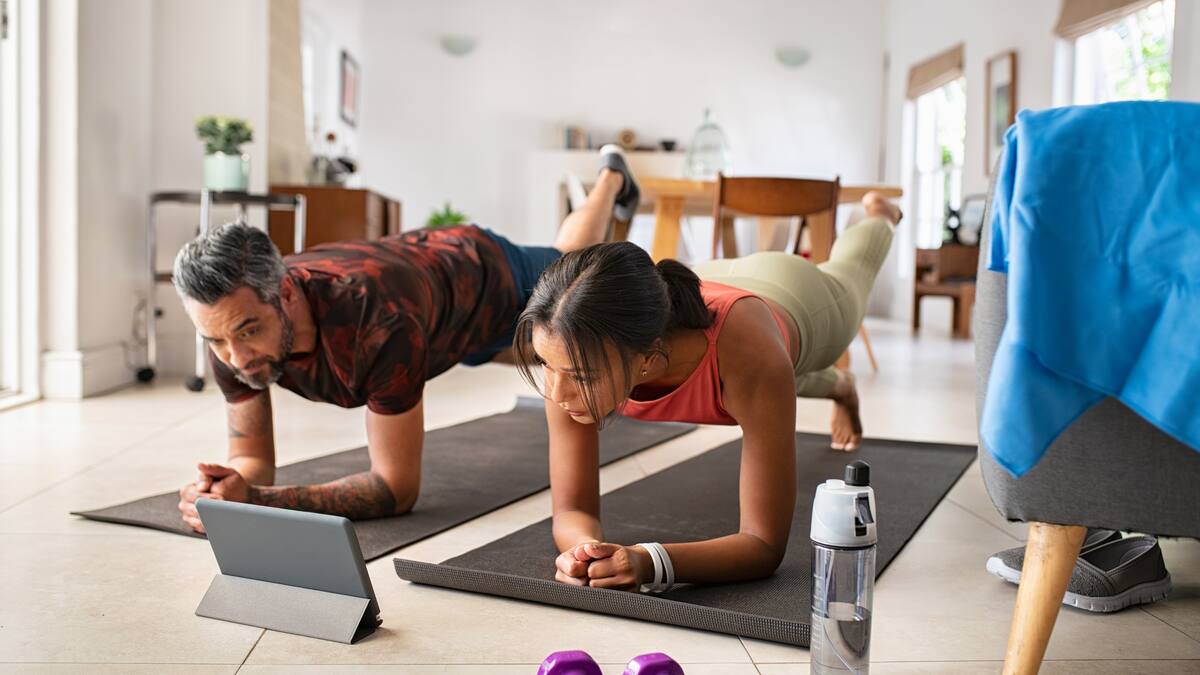Fitness
Should You Exercise While Under the Weather?

This article was originally published on Oxygen.
If you are consistently active, you probably feel strong, healthy and at times utterly invincible. This can make it doubly painful when your body does succumb to illness which, let’s face it, happens to the best of us. Not only do you feel icky when you’re sick, but you’re also discouraged from doing the one thing that makes you feel great: exercise.
There are a number of infections we can pick up throughout the year, some worse than others. While we’ve always been told to avoid working out while sick, it’s tempting to ask how sick is sick, and what counts as “working out”? Is a light walk OK, or should you avoid any activity altogether? Can you do weights at home? Here’s the real question: When (if ever) is it OK to exercise while you’re sick?
As it turns out, the question of whether you should work out while sick may depend on what you’re sick with and the severity of your symptoms. While a fever and upset stomach would stop most of us from even thinking about touching a weight, a stuffy nose and headache might actually benefit from a few minutes of movement. Here’s what you need to know to decide whether you should be working out while sick.
When to Avoid the Gym
Under “normal” conditions, exercise is an acute stress that can temporarily suppress your immune system. As Kristina Kendall, Ph.D., lecturer at Edith Cowan University’s School of Medical and Health Sciences, explains, this really isn’t as bad as it sounds. “Your body’s immune system usually recovers within a couple of hours, assuming you are healthy and not already battling an infection,” she says. Over time, this pattern can actually build a stronger immune system.
However, when your immune system is already compromised (i.e., when you’re already sick), exercise will only make things worse. “Rarely would I recommend working out while sick, especially if it is a viral illness,” Kendall says. Viral infections can be spread through the air or on surfaces, while bacterial infections are spread through direct contact. Since working out while sick puts you in close proximity to others touching the same equipment, it’s best to stay out of the gym when you’re sick, both for your own health and for others.
“Working out while experiencing symptoms of a cold or flu not only can slow down the recovery process, but it also can put those around you at risk,” Kendall says.
When to Wait It Out
How much rest you take also depends on the type of illness you have. If you’re experiencing a sinus infection or a head cold, for example, you can start working out once your primary symptoms (headache, sinus pressure, etc.) subside. You may feel good enough to go for a walk or a light bike ride after five to seven days, although in some cases, cold symptoms can last up to two weeks.
As long as you’re not battling below-the-neck symptoms like fever, tightness in the chest, sore throat or stomach ache, a light workout might even help clear up some of that lingering congestion. On this point, Kendall agrees. “Once the heavy symptoms are gone, getting some fresh air, sweating a bit, increasing blood flow and moving your body can actually feel pretty nice,” she says.
Infections that affect your respiratory system — chest cold, flu, pneumonia — are a whole different story. These types of illnesses can make breathing very difficult during exercise, so Kendall recommends waiting to work out until symptoms have passed completely. This is also another instance when your health can affect the health of those around you. If you have a respiratory infection and are coughing and contagious, stay away from public gyms. Nobody wants your germs.
How to Bounce Back
Another thing to consider when weighing whether to work out is whether other factors might be off. As Kendall points out, in addition to making you feel crummy, illness can throw your sleep schedule, hydration and eating patterns off.
“Poor sleep, inadequate nutrition and dehydration only compound the negative effects of working out while sick,” she says. So not only will your performance during the workout suffer, but you’ll also probably do more harm than good and lengthen the time it takes your body to recover.
The take-away message? You really won’t see any improvements in performance and/or physique if you exercise while sick. Use this forced downtime to sleep, hydrate and recover. According to Kendall, if you allow your body to fully rest and recover, you’ll gain back any fitness losses more quickly than if you try to push through.
“Rest does a body good,” she says. “If you let your body fully heal, it’s also less likely you’ll catch another cold/virus in a couple of weeks.” So take a week off — big deal! You’ll gain back any fitness that you lost pretty quickly once you’re feeling better.
If you absolutely must exercise, you can get outside (not in a public gym where you can spread germs) and do some light exercise once your symptoms subside. When in doubt, check with your doctor for his or her recommendations and to learn how long you might be contagious for. This will definitely let you know when you can safely return to the gym.

Fitness
How to Do Sit-Ups Safely and Alternatives to Try, According to Experts
:quality(85):upscale()/2024/11/20/243/n/1922729/baf0a4d0673ebc22d10e62.97860279_.jpg)
When most people think of a strong core or achieving abs, the first exercise that comes to mind is often sit-ups. While sit-ups have long been a go-to for strengthening the core, they’re not always the most effective or safest option for everyone. Proper form and technique are key to maximizing the benefits of sit-ups while avoiding strain on the back and neck.
To provide a well-rounded perspective on how to do sit-ups, we spoke with three experts who shared their insights on the benefits and potential risks of sit-ups, as well as alternative exercises that can help build a strong core without the same level of stress on the body. Their advice offers a balanced view of how to approach core training, ensuring safety, effectiveness, and overall fitness progress. Whether you’re a beginner or a seasoned athlete, understanding how to incorporate sit-ups — or how to replace them with other movements — can help you reach your fitness goals more efficiently and safely.
Many expectant mothers, especially, wonder if sit-ups are safe during pregnancy and whether they should incorporate them into their fitness routines. To provide expert guidance, we spoke with a specialist who will weigh in on the safety and recommendations for core exercises during pregnancy.
Experts Featured in This Article:
Leia Rispoli, MD, is a double board-certified interventional pain management specialist and physiatrist at DISC Sports & Spine Center.
Anna Larson, PT, DPT, is a doctor of physical therapy at Fusion Wellness and Femina Physical Therapy in Los Angeles, CA.
Meleen Chuang, MD, is a clinical associate professor for the Department of Obstetrics and Gynecology at NYU Grossman School of Medicine, chief of Obstetrics and Gynecology at NYU Langone Hospital Brooklyn, and medical director of Women’s Health, Family Health Centers at NYU Langone (FHC).
Todd Sinett, DC, is the CEO of Tru Whole Care and founder of Backbridge, a back pain device. Dr. Sinett has published four books on treating back pain, available on Amazon.
Sit-Ups: Muscles Worked and Benefits
Most people might assume crunches and sit-ups are the same exact exercise. However, there are a few key differences to note for each movement, particularly when it comes to the muscles involved. “While the terms ‘crunches’ and ‘sit-ups’ are sometimes used interchangeably, sit-ups are usually hinged from the waist, and crunches can be more of a curling of a spine, but it really depends on who you talk to and how people use these terms,” Leia Rispoli, MD, says. “Classically, a crunch is more of a curled movement from a flat position where your elbows meet your knees vs. a sit-up, which is a hinge from the waist with a persistent stable and flat spine.”
When it comes to performing sit-up exercises, the main muscles used are the rectus abdominis, obliques, transverse abdominis, and hip flexors. “The specific muscles that are worked and utilized involve your core muscles (mostly your anterior core muscles), so all your abdominal muscles, and hip flexor muscles,” Dr. Rispoli says.
A sit-up exercise “involves your abdominals and hip flexors as well because it combines spinal flexion and hip flexion,” Anna Larson, PT, DPT, says. “While crunches involve mostly your abdominal muscles, because the motion is achieved only with spinal flexion.”
There are benefits of sit-ups that relate to movements in everyday life. “A lot of core muscle strength and stability helps protect and preserve the spine,” Dr. Rispoli says. “In general, this helps establish a persistent habit of good posture, which ultimately puts the spine in a protective mode against years of degeneration.”
“Our abdominal muscles form a large part of our core, which give us stability, balance, and improved posture,” Dr. Larson adds. “Strengthening your abdominal muscles also will increase your pelvic floor strength. Improved pelvic floor strength will help to decrease the risk of urinary incontinence and prolapse.”
How to Do Sit-Ups Safely
- Start by lying on the floor, with your back against the ground, knees bent and feet flat on the floor.
- Place both arms crossed at the front of the chest.
- Bring your upper body and torso up towards your knees.
- Slowly lower yourself back down to the floor, with control.
Some might want to start out with both hands behind your neck, but for safety, try to keep the arms crossed at the chest first, especially if you’re a beginner. “You want to keep your lumbar spine and your neck and your head all in one plane,” Dr. Rispoli advises. “You don’t want to put any extra flexion or strain on the neck, and you don’t want to use your arms that are positioned behind your head to hinge your neck in a flexion position and pull from there.” She adds: “If the initial engagement of the muscles is too difficult to get off of the floor immediately for those first few degrees, then you should use some sort of propped mat to help eliminate those first few degrees of difficulty.”
Note for beginners: “When starting out with this exercise, it is helpful to have someone stabilize your feet or place your feet under something sturdy such as a couch,” according to Dr. Larson. “Placing a small ball or a couple of pillows behind the back can help to engage the deeper abdominal muscles and help increase your strength gradually over time.”
“The best starting position is with a pillow behind the back or small ball, as this will help encourage spinal flexion, and the engagement of the abdominals instead of overrecruiting the hip flexors. This also decreases the load to the neck as the angle takes some of the strain from the neck muscles and focuses more on the abdominals,” Dr. Larson adds.
Sit-Up Alternatives
Todd Sinett, DC, believes you can do much more than sit-ups to help your core. “I wrote a book entitled ‘Sit-Ups Are Stupid and Crunches Are Crap,’ which provides an outline of exercises and stretches that help to strengthen our core,” he says. “To name a few I love: dead bugs, bird dog, leg raises, planks. You want to focus on exercises that elongate the body and spine.”
Dead bugs: “Anything laying on your back while alternating moving your legs or arms, such as a dead bug, is a great way to build deep core strength,” Dr. Larson says.
Bird dogs: “Another way to challenge core stability is on hands and knees alternating reaching your opposite arm and leg, also called a bird dog.” Dr. Larson adds.
Leg raises or planks: For pre- or post-natal women, “pelvic tilts, modified planks, leg raises, side-lying exercises can help strengthen core while also ensuring safety during pregnancy. Light aerobic exercises, weightlifting, moderate brisk walking, and cycling on a stationary bike are good options,” Meleen Chuang, MD, says.
Pelvic tilts: “An alternative exercise can be something like a pelvic tilt, where you’re in a sit-up position, but instead of raising your upper trunk, you’re just flattening your back to the floor and contracting and engaging your core and abdominal muscles,” Dr. Rispoli, MD, says.
Jade Esmeralda (she/her), MS, CSCS, is a health and fitness staff writer and a strength and conditioning specialist. A lifelong martial artist and dancer, Jade has a strong passion for strength and conditioning, sports science, and human performance. She graduated with a Master of Science degree in exercise science and strength and conditioning from George Washington University.
Fitness
Research Has Unveiled How Many Sets You Need to Do to Build Muscle

New evidence has shed light on the optimal amount of sets we need to be getting through in our workouts in order to build muscle.
Until this point, various studies have suggested that muscle gain will increase as volume increases, with different muscle groups requiring different amounts of sets for optimal muscle growth. However, it hasn’t been studied to the same extent as this particular piece of research.
In a YouTube video shared by Dr Mike Israetel, who holds PhD in Sport Physiology, and sport scientist PhD Dr Milo Wolf, the two experts discussed the findings of the study which was published in Medicine & Science in Sports and Exercise.
Focusing on the quadriceps and trained squats, leg presses and leg extensions, the study compared three training volumes:
- Group 1 (Low Volume): 22 sets of quad training per week, split evenly over 2 workouts.
- Group 2 (Medium Volume): 22 sets of quad training, adding 4 sets of weekly quad training every 2 weeks, resulting in 42 sets per week. This was 32 sets per week on average for the 12-week study.
- Group 3 (High Volume): 22 sets of quad training, adding 6 sets of weekly quad training every 2 weeks, resulting in 52 sets per week. This was 38 sets per week on average for the 12-week study.
The results found that the high volume group (52 sets per week, 38 on average) resulted in greater muscle thickness and size as well as an improvement in strength gains. The study concluded that progressively adding four or six sets per week every two weeks elicited greater lower body strength and size over the 12 weeks.
Does this mean we should be completing 52 sets per week? The experts said it’s unlikely. Linking this study back to our training, it’s suggested that we could increase hypertrophy and strength by completing more than 22 sets a week. This could be achieved by adding 4-6 sets per week. However, that’s not as simple as it may seem.
The study also mentioned that the limited certainty of the findings warrants caution due to the variation between results. For example, in the groups there were quite wide differences in results between participants. It’s also important to add that in this study, the participants were training extremely hard.
To put this into context, the high volume group completed 26 sets of quads with 2 minutes rest. The programme contained:
- 9 sets of squats
- 9 sets of leg press
- 8 sets of leg extension
It’s pretty brutal to say the least, not to mention how much time this would take. A 30-minute lunch break workout this ain’t.
MH says: Not everyone can add more volume to their training, especially to this degree and with every single muscle group. Doing so would likely sacrifice adequate recovery and therefore increase the risk of injury, so of course work within your limitations.
The key takeaway is that despite this study’s findings, you don’t have to work to such high levels as 52 sets per week. However, you could focus on increasing weekly volume from where you are now and ensure you are working close to failure at the end of those sets.
How Many Sets for Building Muscle?
As a rule of thumb work 0-5 reps from failure, with an amount of sets suitable for your experience level.
Referring to a more recent systematic review, it found:
If you want to absolutely maximise muscle growth: 30-40 sets would deliver the best results, but it’s important to note that above this point isn’t for everyone. 10-20 sets would be a more realistic goal.
This could look like:
- 3-6 sets close to failure for a particular muscle group per workout, working on the basis that you train 3 times a week.
You could start here and increase weekly sets gradually as you get stronger and more acclimatised to the amount of work. The most important variable is to train with intensity on a consistent basis.
Using the new research as well as taking an individualised approach to your programming will likely improve your muscle gains, without you needing to skip the stairs.
Fitness
Does prioritizing your fitness help protect your brain health?

We all want to protect our brains and bodies from disease and decline and stay sharp and vibrant throughout the decades. Regular exercise is part of a healthy lifestyle, and it brings a range of benefits, from lowering blood pressure to perking up your mood and prompting the release of feel-good endorphins. Your training habits can benefit your physical health and your brain health, too. For example, an interesting study showed that people who took part in aerobic fitness training had increased brain volume and white and gray matter.
Physical activity can sharpen problem-solving, memory, and learning and reduce depression or anxiety. Another study concluded that cognitive decline is nearly twice as common in adults who are inactive compared to active adults. In a recent study, researchers wanted to look at how exercise lowered the risk of dementia. Let’s take a look at the study and the results.
The study
In a study published in the British Journal of Sports Medicine, the researchers wanted to investigate how cardiorespiratory fitness affected the risk of dementia, taking genetic predisposition into account. The researchers looked at data from 61,214 adult participants who didn’t have dementia.
The researchers identified dementia cases through medical records and assessed genetic predisposition. They used a six-minute submaximal cycling test to determine the participants’ cardiovascular fitness and estimate maximal oxygen consumption or VO2 max. The participants also took neuropsychological tests to evaluate their reaction time, processing speed, and memory. The researchers looked closely at the data to analyze the relationship between cardiovascular fitness and genetic predisposition.
The results

In conclusion, the researchers reported a positive association between a high cardiovascular fitness level and cognitive function across all age groups. High cardiovascular fitness levels were associated with a 40% lower overall risk of dementia and a delayed dementia onset by 1.48 years on average. For individuals with a high predisposed risk of dementia, high cardiovascular fitness was associated with a 35% lower risk of dementia.
What is cardiovascular fitness?

Cardiovascular fitness refers to your ability to deliver oxygen to your working muscles and your heart. Another interesting study revealed that higher cardiovascular fitness levels were linked with a lower risk of heart and blood vessel disorders and complications.
What we can learn from this research

This research shows that having good fitness levels could lower your risk of dementia, delay its onset by up to 18 months, and enhance your cognitive performance. This study shows us that even those with a higher genetic risk of developing dementia can lower that risk with regular exercise. Prioritizing your fitness helps protect your brain health, heart health, and more.
-

 Business1 week ago
Business1 week agoColumn: Molly White's message for journalists going freelance — be ready for the pitfalls
-

 Science6 days ago
Science6 days agoTrump nominates Dr. Oz to head Medicare and Medicaid and help take on 'illness industrial complex'
-

 Politics1 week ago
Politics1 week agoTrump taps FCC member Brendan Carr to lead agency: 'Warrior for Free Speech'
-
/cdn.vox-cdn.com/uploads/chorus_asset/file/25739950/247386_Elon_Musk_Open_AI_CVirginia.jpg)
/cdn.vox-cdn.com/uploads/chorus_asset/file/25739950/247386_Elon_Musk_Open_AI_CVirginia.jpg) Technology1 week ago
Technology1 week agoInside Elon Musk’s messy breakup with OpenAI
-

 Lifestyle1 week ago
Lifestyle1 week agoSome in the U.S. farm industry are alarmed by Trump's embrace of RFK Jr. and tariffs
-

 World1 week ago
World1 week agoProtesters in Slovakia rally against Robert Fico’s populist government
-

 Health3 days ago
Health3 days agoHoliday gatherings can lead to stress eating: Try these 5 tips to control it
-

 News1 week ago
News1 week agoThey disagree about a lot, but these singers figure out how to stay in harmony



















